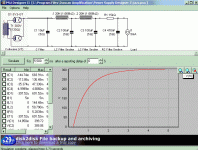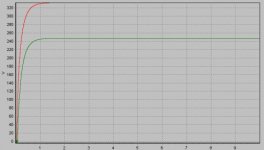Why 12AU7 ?
I would not recommend 12AU7 at all for DIY designs , apart from as a phase splitter (concertina) . If you have a commercial amp then you're stuck with the nasty things . 6SN7 wipes the floor with 12AU7 in a big way so why use the worst when a lot better can be had for about the same price ? 7AF7 are a loctal 12AU7 and again make the 12AU7 sound like a 3rd harmonic enriched wet-fart . I'm still waiting for an answer regarding a tube that sounds worse Can we simply agree that 12AU7 is a trainer-tube , an entry into tube audio and believe me $40 TFK's sound far worse than a $5 7AF7 . BTW Opamps probably sound better and mini-systems don't count
Can we simply agree that 12AU7 is a trainer-tube , an entry into tube audio and believe me $40 TFK's sound far worse than a $5 7AF7 . BTW Opamps probably sound better and mini-systems don't count 
316a
I would not recommend 12AU7 at all for DIY designs , apart from as a phase splitter (concertina) . If you have a commercial amp then you're stuck with the nasty things . 6SN7 wipes the floor with 12AU7 in a big way so why use the worst when a lot better can be had for about the same price ? 7AF7 are a loctal 12AU7 and again make the 12AU7 sound like a 3rd harmonic enriched wet-fart . I'm still waiting for an answer regarding a tube that sounds worse

316a
316,
The gentleman already stated that he is aware that there are people out there who dislike this particular tube, and he would like to use it anyway. So can you please give it a rest with the "12AU7's come from hell" routine? If you want, start your own thread on 12AU7's. Thanks.
Joel
The gentleman already stated that he is aware that there are people out there who dislike this particular tube, and he would like to use it anyway. So can you please give it a rest with the "12AU7's come from hell" routine? If you want, start your own thread on 12AU7's. Thanks.

Joel
I would imagine that a lot of tube dealers would have a quanity of good used 12AU7s around that they would be happy to sell very reasonable. This might not be the best tube out there but they are very common and not expensive and so a good tube to try out the many brands and mil spec types, in other words a great tube type for rolling. For experimentation and learning how different brands can effect the sound it is a very good choice. Because of the great variety 12AU7s offer at low cost a very important aspect of tube audio is there. Fun.
I copied the specs of the choke and caps from Gabe's website (his first power supply page).ShiFtY said:I would use a bigger choke, 10H at ~40mA is still quite small.
Also use a slightly bigger first cap and probably only 100uF or so after the choke.
In case you are interested, there is a free power supply design tool to download at www.duncanamps.com
They also have a downloadable tube database which is a godsend.
http://members.tripod.com/~gabevee/mypwrsup.html
I am wondering what the "rule of thumb" is with chossing the inductance and resistance of a choke.
I downloaded Duncan software and am not quite sure yet how to use it.
I found from Angela that they carry 10 H choke with ~200 Ohms resistance. So, with this the voltage drop by the choke will get doubled compared with 5 H one with ~100 Ohms.
Hmm, I think I 'll have to check the voltage drop by the rectifier first to get the right B+ voltage.
Thanks Joel. Exactly what I was thinking.Joel said:316,
The gentleman already stated that he is aware that there are people out there who dislike this particular tube, and he would like to use it anyway. So can you please give it a rest with the "12AU7's come from hell" routine? If you want, start your own thread on 12AU7's. Thanks.

Joel said:Use a constant current load.
Would you mind explaining more in detail, Joel?
If you right-click on the load resistor, you'll be able to change it to a constant current load. Figure out how much current your tube will draw based on its operating point, and use that value for the load. This works better than modelling using a load resistor, because every time you change B+ voltage, you'll have to figure out a new resistor value to get the current draw you're trying to model for. If you put a current load in there, you're done and don't have to worry about it. Speaking in simple terms, of course.
Another advantage of current loads is using the 'stepped load', which lets you change the value of the current draw at a specified point in time. This lets you see how much the PS voltage will sag (or oscillate or whatever) when the current demand changes. It's a good way of comparing different PS designs to see which one is 'stiffer'.
Hope that helps.
Saurav
Another advantage of current loads is using the 'stepped load', which lets you change the value of the current draw at a specified point in time. This lets you see how much the PS voltage will sag (or oscillate or whatever) when the current demand changes. It's a good way of comparing different PS designs to see which one is 'stiffer'.
Hope that helps.
Saurav
I'm playing around with Duncan Power Supply Designer. I have the first filter cap of 10uF, and two LC filters with 20H chokes of 1.6k Ohm resistance (according to Hammond specs), and a RC filter with 0.47uF cap and R as a variable. In order to get the target B+ voltage, I tried changinig R value to ~ 15k, then I have a popup saying that "a current sink has pulled the voltage below zero for more than 5 mains cycles, at time 0.083S". What does it mean? Well, I cannot even be sure if I'm doing this thing right. 
Please post the *.psu file you have made. Someone (maybe me) will look at it. This is the quickest way, I think,JAZZ2250 said:I'm playing around with Duncan Power Supply Designer. I have the first filter cap of 10uF, and two LC filters with 20H chokes of 1.6k Ohm resistance (according to Hammond specs), and a RC filter with 0.47uF cap and R as a variable. In order to get the target B+ voltage, I tried changinig R value to ~ 15k, then I have a popup saying that "a current sink has pulled the voltage below zero for more than 5 mains cycles, at time 0.083S". What does it mean? Well, I cannot even be sure if I'm doing this thing right.
Cheers,
PS You'll have to zip it.
Hi Jazz,
Like all computer I've ever come across, the error message does not equate with the problem.
In this case, it seems that it's just a timeout problem. The values you have chosen take 5 seconds to settle. Extend your simulation time and ignore the message.
Play around with values. Ask what ripple value is acceptble for a buffer such as yours. Although I'm a power supply protagonist, its wasteful to spend too much on one.
Lets see what others think...
Cheers,
Like all computer I've ever come across, the error message does not equate with the problem.
In this case, it seems that it's just a timeout problem. The values you have chosen take 5 seconds to settle. Extend your simulation time and ignore the message.
Play around with values. Ask what ripple value is acceptble for a buffer such as yours. Although I'm a power supply protagonist, its wasteful to spend too much on one.
Lets see what others think...
Cheers,
Attachments
Ah yeah, that power supply is probably overkill, you have gone into the area of diminshing returns.
You may want to try "drawing" a square on the graph curve, the program zooms in on that part of the curve. Use the X button to zoom out.
Basically for a preamp you want to minimise the ripple as much as you can.
Also each section of a 12AU7 will draw 5mA or so (I think?) I guess aim for 10mA total draw.
I get good results from a 20uF first cap, a 20H choke and another 20uF cap. The voltage is not too crucial, i guess +/- 10% would be considered ok.
Also 5 ohms is pretty high ESR (equivalent series resistance) for a cap, most modern ones are 1 or 2 ohms at the most, (and way less sometimes)
You may want to try "drawing" a square on the graph curve, the program zooms in on that part of the curve. Use the X button to zoom out.
Basically for a preamp you want to minimise the ripple as much as you can.
Also each section of a 12AU7 will draw 5mA or so (I think?) I guess aim for 10mA total draw.
I get good results from a 20uF first cap, a 20H choke and another 20uF cap. The voltage is not too crucial, i guess +/- 10% would be considered ok.
Also 5 ohms is pretty high ESR (equivalent series resistance) for a cap, most modern ones are 1 or 2 ohms at the most, (and way less sometimes)
Hmmm. No comment on my selection of parts...
Anyway, I'll order parts as shown above. One thing I wonder is the voltage entering choke is slightly lower than the rating of the choke (~400VDC). I hope it won't matter.
After I finish the preamp with 12au7 and taste it for a while, I'll replace the resistor to a lower value (to give 250V DC at higher current) and put 5687 in place of 12au7. It seems interesting, well... at least to me. Then, I'll be able to tell the difference btwn 12au7 and 5687.
Anyway, I'll order parts as shown above. One thing I wonder is the voltage entering choke is slightly lower than the rating of the choke (~400VDC). I hope it won't matter.
After I finish the preamp with 12au7 and taste it for a while, I'll replace the resistor to a lower value (to give 250V DC at higher current) and put 5687 in place of 12au7. It seems interesting, well... at least to me. Then, I'll be able to tell the difference btwn 12au7 and 5687.
- Status
- This old topic is closed. If you want to reopen this topic, contact a moderator using the "Report Post" button.
- Home
- Amplifiers
- Tubes / Valves
- First time building a tube amp: Help please


